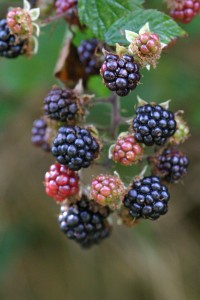 If you think of berries and fruits such as brambles (blackberries), rowans, hips, raspberries and sloes, then you may think of the ways we utilise these under the host of recipes that have been used. However, at this time of the year they are, and will be, becoming increasingly important for wildlife. For example it will not be long before the redwings and fieldfares descend on the countryside hoping that the rowan berries will be abundant. How many of these attractive thrushes migrate to us depends on the food available, including rowan berries in Scandinavia where most of them come from. At the moment the crop in the Highlands is patchy although abundant in some areas. Even if it is a good crop they will not last long and the thrushes will have to move on to find more berries to last them the winter months. A few pairs of both species stay to breed but in very small numbers compared with the winter flocks. Between 40 and 80 pairs of redwings nest in the Highlands most years but the fieldfares are rare at only around five pairs. However, before the redwings and fieldfare arrive the resident birds, blackbirds, mistle thrushes and song thrushes will tackle the rowan berries and will even take them before they are fully ripened.
If you think of berries and fruits such as brambles (blackberries), rowans, hips, raspberries and sloes, then you may think of the ways we utilise these under the host of recipes that have been used. However, at this time of the year they are, and will be, becoming increasingly important for wildlife. For example it will not be long before the redwings and fieldfares descend on the countryside hoping that the rowan berries will be abundant. How many of these attractive thrushes migrate to us depends on the food available, including rowan berries in Scandinavia where most of them come from. At the moment the crop in the Highlands is patchy although abundant in some areas. Even if it is a good crop they will not last long and the thrushes will have to move on to find more berries to last them the winter months. A few pairs of both species stay to breed but in very small numbers compared with the winter flocks. Between 40 and 80 pairs of redwings nest in the Highlands most years but the fieldfares are rare at only around five pairs. However, before the redwings and fieldfare arrive the resident birds, blackbirds, mistle thrushes and song thrushes will tackle the rowan berries and will even take them before they are fully ripened.
Hips are the berries of the hawthorn and the birds that take to these the most are the blackbirds closely followed by song thrushes, mistle thrushes and, interestingly, robins. One interesting piece of behaviour is with the mistle thrushes, perhaps because they are larger than the others, even the blackbirds. As a family group the mistle thrushes will defend a rowan tree, particularly if it is an isolated tree, against all incomers. They will even defend such trees when the immigrant redwings and fieldfares come in but will eventually succumb to the sheer numbers of the immigrants.
Sloes are the berries of the blackthorn and this year the crop seems to be very poor. I looked at some blackthorn bushes close to my house last week and could find very few berries and those that I did find still had a very long time to go before they would reach full size. Song thrushes are very partial to them, so much so that they are the commonest bird to take them. However, birds seem, for some reason, to find difficulty in tackling them and do not take them until the winter starts. There is the theory that it takes the first hard frost to soften the dark berries before the birds in general will take them and then they do with apparent relish.
In contrast to the sloes the wild raspberries seem to have had a good season and I have already picked a few that have been ripe enough to eat on the spot. Not many birds seem to take these luscious looking, to us, berries, but one intriguing one is the blackcap. Last, but not least, are the ubiquitous brambles, some call them blackberries. Perhaps above all these are the berries that we tend to use the most for a wide variety of recipes. A quick look at these bushes last weekend seem to confirm they will be late with few of the luscious dark berries ready and a high percentage of the red, unripe berries present as in the photograph. The usual thrushes will take them but one unusual bird is the starling that just love them.
The best book on the subject of birds, wild berries and fruits is “Birds and Berries” by Barbara and David Snow published in 1988 in the famous T & A D Poyser series of natural history books.
Next time will look at the way we ourselves utilise the berries and fruits of the Highland countryside, as a pastime of using wild food that has declined drastically in recent years.
Tags: highland flora
